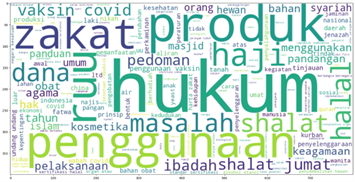Exploring Semantic Similarity among MUI Fatwas: A Computational Analysis using Generalized Jaccard Similarity
DOI:
https://doi.org/10.12962/j22759970.v4i2.1217Keywords:
Generalized Jaccard Similarity, WordNet, Natural Language Processing, Islamic Documents, MUIAbstract
Majelis Ulama Indonesia (MUI) plays a crucial role in the Islamic landscape of Indonesia, influencing religious discourse and societal norms. As a primary contributor to policy formulation and the issuance of Islamic fatwas, the MUI significantly impacts the lives of Muslims. However, challenges arise when certain fatwas exhibit similarities, necessitating deeper analysis to understand their differences. Despite limited prior research, there is an urgent need for a computational framework to comprehensively assess fatwa similarities. This study addresses this gap by employing the Generalized Jaccard Similarity method with WordNet, demonstrating its effectiveness compared to the Jaccard method with a 25.86% improvement in string matching quality for evaluating MUI fatwa titles. The Generalized Jaccard similarity analysis reveals that 73 documents exhibit similarity scores greater than 0.5, indicating significant resemblance, while 77,028 documents have scores less than 0.5, indicating lower similarity or dissimilarity. These figures reflect varying degrees of document similarity based on Generalized Jaccard.
References
R. Muhaimin and J. Muslimin, “The Role of the Council of Indonesian Ulama (MUI) to the Development of a Madani Society in the Democratic Landscape of Indonesia,” Aspirasi: Jurnal Masalah-masalah Sosial, vol. 14, no. 2, Dec. 2023, doi: 10.46807/aspirasi.v14i2.3368.
D. Khairani, A. Lubis, Zulkifli, H. T. Sukmana, K. Faruqi, and Y. Durachman, “Keywords Searching XML Data for Fatwa in Indonesia,” in 2019 7th International Conference on Cyber and IT Service Management (CITSM), IEEE, Nov. 2019, pp. 1–4. doi: 10.1109/CITSM47753.2019.8965394.
I. Izmuddin, R. Rusyaida, G. Bashir, P. Hasibuan, and A. Awaluddin, “The Indonesian Ulema Council Fatwa Analysis on The Environment and Their Relationship to The Green Economics Concept Development,” Jurnal Syntax Admiration, vol. 3, no. 12, pp. 1559–1568, Dec. 2022, doi: 10.46799/jsa.v3i12.536.
V. R. Fierdaus, M. A. Bijaksana, and W. Astuti, “Building Synonym Set for Indonesian WordNet using Commutative Method and Hierarchical Clustering,” JURNAL MEDIA INFORMATIKA BUDIDARMA, vol. 4, no. 3, p. 778, Jul. 2020, doi: 10.30865/mib.v4i3.2254.
N. A. Rakhmawati and M. Jannah, “Food Ingredients Similarity Based on Conceptual and Textual Similarity,” Halal Research Journal, vol. 1, no. 2, pp. 87–95, Oct. 2021, doi: 10.12962/j22759970.v1i2.107.
R. Gnanakumari and P. Vijayalakshmi, “Generalized Jaccard Similarity Based Recurrent DNN for Virtualizing Social Network Communities,” Intelligent Automation & Soft Computing, vol. 36, no. 3, pp. 2719–2730, 2023, doi: 10.32604/iasc.2023.034145.
M. Raffiudin, “Exploring Sacred Texts: Leveraging Computer Science for Dataset Similarity Analysis in Religious Studies,” Apr. 2024, pp. 227–235. doi: 10.4028/p-kE3XmS.
A. Olowolayemo, N. H. Daud, M. G. Tanni, and M. A. Omar Ba Khadher, “An All-Inclusive Digital Framework for Collaborative Community Transformation for Sustainable Development,” International Journal on Perceptive and Cognitive Computing, vol. 9, no. 1, pp. 1–13, Jan. 2023, doi: 10.31436/ijpcc.v9i1.285.
R. Singh and S. Singh, “Text Similarity Measures in News Articles by Vector Space Model Using NLP,” Journal of The Institution of Engineers (India): Series B, vol. 102, no. 2, pp. 329–338, Apr. 2021, doi: 10.1007/s40031-020-00501-5.
S. H. Park and K. Kim, “Collaborative filtering recommendation system based on improved Jaccard similarity,” J Ambient Intell Humaniz Comput, vol. 14, no. 8, pp. 11319–11336, Aug. 2023, doi: 10.1007/s12652-023-04647-0.
M. AlMousa, R. Benlamri, and R. Khoury, “Exploiting non-taxonomic relations for measuring semantic similarity and relatedness in WordNet,” Knowl Based Syst, vol. 212, p. 106565, Jan. 2021, doi: 10.1016/j.knosys.2020.106565.
D. Zhang, X. You, S. Liu, and K. Yang, “Multi-Colony Ant Colony Optimization Based on Generalized Jaccard Similarity Recommendation Strategy,” IEEE Access, vol. 7, pp. 157303–157317, 2019, doi: 10.1109/ACCESS.2019.2949860.
L. Hickman, S. Thapa, L. Tay, M. Cao, and P. Srinivasan, “Text Preprocessing for Text Mining in Organizational Research: Review and Recommendations,” Organ Res Methods, vol. 25, no. 1, pp. 114–146, Jan. 2022, doi: 10.1177/1094428120971683.
T. Jang, J. Ahn, and S. L. Kim, “Punctuation restoration Model and Spacing Model for Korean Ancient Document,” Dec. 2023, [Online]. Available: http://arxiv.org/abs/2312.11881
A. Irsyad and N. A. Rakhmawati, “Community detection in twitter based on tweets similarities in indonesian using cosine similarity and louvain algorithms,” Register: Jurnal Ilmiah Teknologi Sistem Informasi, vol. 6, no. 1, pp. 22–31, 2020, doi: 10.26594/register.v6i1.1595.
J. Praveen Gujjar, H. R. Prasanna Kumar, and M. S. Guru Prasad, “Advanced NLP Framework for Text Processing,” in 2023 6th International Conference on Information Systems and Computer Networks (ISCON), IEEE, Mar. 2023, pp. 1–3. doi: 10.1109/ISCON57294.2023.10112058.

Downloads
Published
How to Cite
Issue
Section
License
Copyright (c) 2024 Alfado Rafly Hermawan, Shofa Wardatul Jannah

This work is licensed under a Creative Commons Attribution-NonCommercial 4.0 International License.
Copyright
Authors who publish their manuscripts in this journal agree to the following terms:
- The copyright of each article remains with the authors.
- Halal Research Journal holds the right to publish the article first under the Creative Commons Attribution 4.0 International License.
- Authors may distribute their published manuscripts non-exclusively (e.g., to institutional repositories or as part of book publications), provided they acknowledge that the article was first published in this journal.
License
Articles published in this journal are licensed under the Creative Commons Attribution 4.0 International License. This license permits anyone to:
- Copy, distribute, adapt, modify, and create derivative works from the material in any form, including for commercial purposes.
- The condition is that proper credit must be given to the authors for the original work.













